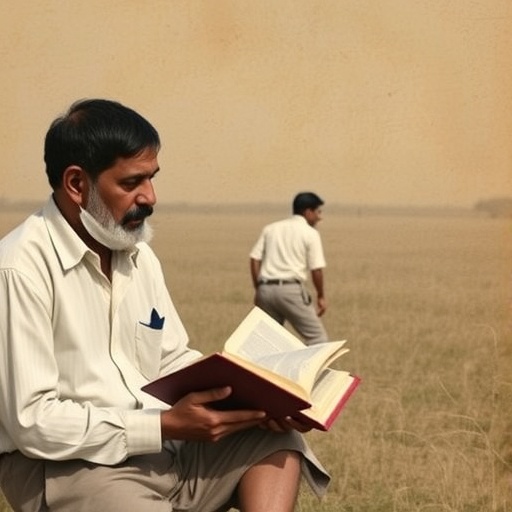In a revelation poised to reshape our understanding of Sanskrit scholarship during colonial India, a groundbreaking research initiative led by the University of Cambridge is set to explore the remarkable intellectual vibrancy that flourished in rural Brahmin settlements, or agrahāras, across the Kaveri Delta. Contrary to the long-held narrative that British domination stifled Sanskrit learning, this project unveils two centuries preceding the British Raj as an unexpected golden age for Sanskrit intellectualism, marked by the prolific production of poetry, philosophy, legal treatises, and theatrical works.
The term ‘pundit’ is familiar worldwide, yet its roots in the Sanskrit word paṇḍita — meaning ‘learned scholar’ — often go unrecognized. It is these pundits, custodians of Sanskrit knowledge, who continued to cultivate the literary and philosophical traditions of India in relative isolation from the upheavals of colonial urban centers. Their persistence ensured the survival and evolution of Sanskrit long after classical patronage systems waned, challenging prevailing assumptions of cultural decline under British rule.
This project hinges on exhaustive fieldwork and archival research in the rural heartlands of southern India, regions historically dotted with Brahmin settlements endowed with land grants by Maratha rulers. The durability of these grants, typically exempt from taxation and inheritable, effectively shielded scholars from the socioeconomic disruptions besetting urban and courtly life, providing an environment conducive to sustained intellectual effort. Thus, these villages served not only as residences but as vibrant hubs of scholarship and cultural production.
A central focus is the identification and analysis of manuscripts that remain untranslated or uncatalogued, many of which have been obscured in Western academia. By systematically documenting authorship, chronology, and the interconnectedness of texts and communities, the research team aims to reconstruct a dynamic scholarly network that thrived in what has traditionally been viewed as the periphery of Sanskrit literary activity.
During this period, Sanskrit education was traditionally confined to elite Brahmin males immersed in the Vedic curriculum. However, with the rise of English-language schools post-1799—after the East India Company’s consolidation of power—there was an observable shift in educational aspirations among Brahmin families. Yet, rather than signaling an outright demise of Sanskrit scholarship, these rural settlements formed a bastion of continuity, maintaining scholarly rigor away from the influence of Anglicized education reforms.
The Kaveri Delta’s agrahāras emerged as focal points not only for literary activities but also for religious observances, characterized by temples dedicated to deities like Vishnu and Shiva, and institutions known as Sabhas, which functioned as forums for both administrative governance and intellectual exchange. The interdependence of religious practice and scholarship underpinned the resilience of these communities, firmly rooting intellectual pursuits within the social and spiritual fabric of the region.
Patronage played a critical role throughout this period. The Maratha Bhonsle dynasty, enthroned as cultured and strategic rulers, endowed scholarly families with land and privileges, fostering an environment where intellectual and artistic innovation could flourish. This patronage extended beyond mere material support; it inspired the creation of works celebrating rulers themselves, including biographies, family chronicles, and even sophisticated erotic literature that blended courtly praise with literary finesse.
Among the eminent scholars of this era was Sridhara Venkatesa ‘Ayyaval’, an influential poet-saint instrumental in the development of the nāmasiddhānta tradition, which emphasizes the chanting of divine names as a pathway to spiritual ecstasy. His legacy epitomizes the spiritual dimensions intertwined with intellectual endeavors within these settlements, offering fresh insights into the multifaceted nature of Sanskrit intellectual culture.
The village of Tiruvisainallur stands out as a microcosm of this scholarly efflorescence, having been founded on land granted by Shahaji Bhonsle to a cohort of distinguished pundits. Figures like Ramabhadra Dikshita, whose Sanskrit play Jānakīpariṇaya enjoyed sustained popularity until recent decades, and the innovative Pandora of Sanskrit thought Ramasubba Shastri, defined this locale’s intellectual landscape. Their scholarly rivalry with contemporaries such as Tyagaraja Dikshita underscores a vibrant, contested intellectual environment rather than a stagnant tradition.
By combining field visits, examination of land records, and manuscript studies, the research seeks to map the spatial and social dynamics of these settlements, elucidating how they functioned as nodes of knowledge creation and dissemination. The project also involves engagement with descendants of these scholarly families, many of whom continue to inhabit the region despite the marked decline of these settlements since the early twentieth century.
The significance of this research extends beyond academia, challenging entrenched perceptions that Sanskrit intellectual life was confined to elite courts and urban centers. Instead, it illuminates a rich vernacular tradition where Sanskrit and local Tamil scholarship engaged in dynamic interchange, producing hybrid forms of intellectual expression that have largely escaped modern recognition.
This timing aligns with efforts to revitalize Sanskrit studies at Cambridge, which boasts a storied history in the field dating to the 19th century, along with a world-class Sanskrit manuscript collection. The project’s interdisciplinary team, which includes scholars from international institutions such as the École des Hautes Études en Sciences Sociales and the Hebrew University of Jerusalem, highlights a collaborative commitment to reinvigorate Sanskrit studies on a global scale.
Ultimately, the research reclaims the legacies of these pundits, rediscovering forgotten manuscripts and communities that played a pivotal role in preserving and advancing one of the world’s most ancient and profound intellectual traditions during a period of immense colonial transformation. As such, it promises to add nuance to our understanding of cultural resilience and intellectual history in pre-modern South Asia.
Subject of Research:
The endurance and evolution of Sanskrit scholarship in rural Brahmin settlements (agrahāras) of the Kaveri Delta during the late 17th to early 19th centuries, examining manuscripts, patronage, and intellectual networks under colonial pressures.
Article Title:
Beyond the Court: Rediscovering Sanskrit Scholarship in the Colonial Kaveri Delta
News Publication Date:
Not specified in the source content.
Web References:
Research project page at University of Cambridge (to be updated upon release).
References:
None explicitly cited in the provided content.
Image Credits:
Dominik Wujastyk
Keywords:
Sanskrit scholarship, pundits, colonial India, Kaveri Delta, Brahmin settlements, Maratha Bhonsle dynasty, nāmasiddhānta, Sanskrit manuscripts, intellectual history, cultural resilience




